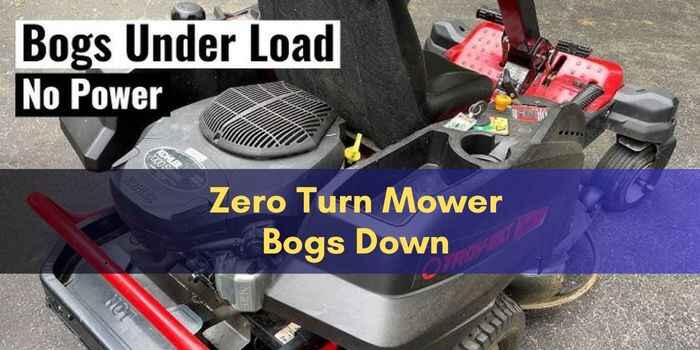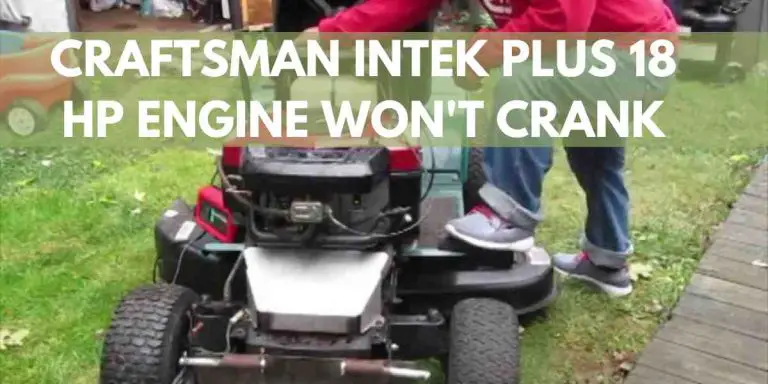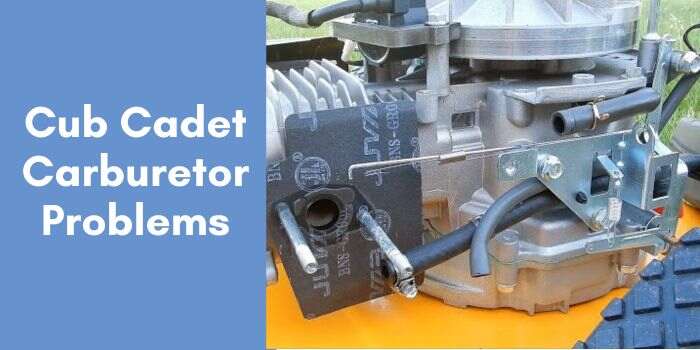Cub Cadet Steering Problems: Troubleshoot and Fix with These Expert Tips!
Cub Cadet steering problems can be resolved by checking the steering system for any loose components or damaged parts and repairing or replacing them as needed. A thorough inspection and maintenance routine can prevent steering problems and ensure smooth operation of the Cub Cadet mower.
Additionally, regular lubrication of the steering mechanism and proper tire inflation can contribute to better steering performance. By addressing these issues promptly, users can enjoy a hassle-free mowing experience and extend the lifespan of their Cub Cadet equipment.
Common Steering Problems With Cub Cadet Tractors
Cub Cadet tractors are known for their superior performance and reliability. However, like any other machine, they can experience steering issues from time to time. If you own a Cub Cadet tractor and are experiencing steering problems, it’s vital to address them promptly to prevent further damage and ensure smooth operation. In this article, we will discuss some of the common steering problems that Cub Cadet tractor users may encounter. By understanding these issues, you’ll be better equipped to diagnose and resolve any steering problems you may come across. Let’s dive in!
Excessive Play in the Steering Wheel
One of the most common steering problems that Cub Cadet tractor owners face is excessive play in the steering wheel. When there is excessive play, you may notice that the steering wheel feels loose and has a significant amount of movement before the wheels respond.
There are a few possible causes for this problem. One cause could be worn-out or damaged steering components, such as the tie rod ends or the steering gear. Another cause could be improper adjustment of the steering mechanism.
To address this issue, you should start by inspecting the steering components for any signs of wear or damage. If you notice any issues, replacing the damaged parts may resolve the excessive play problem. Additionally, you may need to adjust the steering mechanism to tighten it up, ensuring a more responsive steering experience.
Difficulty Steering on Uneven Terrain
Another steering problem that Cub Cadet tractor owners may encounter is difficulty steering on uneven terrain. This issue can make maneuvering the tractor challenging, especially when navigating bumps, ditches, or hills.
There are a few potential reasons for this problem. One possibility is that the tire pressure is not appropriately adjusted. If the tires are overinflated or underinflated, it can affect the tractor’s ability to grip the ground properly, leading to difficulty steering.
Another potential cause is improper wheel alignment. If the wheels are not aligned correctly, it can create resistance while steering, making it harder to navigate uneven terrain.
To address this issue, start by checking the tire pressure and adjusting it according to the manufacturer’s recommendations. Additionally, ensure that the wheels are properly aligned. If the problem persists, it may be beneficial to consult a professional who can provide further guidance and assistance.
Inconsistent Steering Response
The third common steering problem Cub Cadet tractor owners may experience is inconsistent steering response. This issue can manifest as delayed response or unpredictable steering behavior, making it challenging to maintain control of the tractor.
Several factors can contribute to this problem. One possibility is low power steering fluid levels or contaminated fluid, affecting the hydraulic system’s performance. Another potential cause is a malfunctioning power steering pump or a worn-out belt.
To address this issue, start by checking the power steering fluid levels and ensuring they are at the recommended level. If the fluid is dirty or contaminated, it may be necessary to drain and replace it. Additionally, inspect the power steering pump and belt for any signs of damage or wear. Replacing these components if necessary should help restore consistent steering response.
By being aware of these common steering problems and their potential causes, you’ll be better equipped to address any issues you encounter with your Cub Cadet tractor’s steering system. Remember, regular maintenance and prompt attention to steering problems can help ensure smooth operation and extend the life of your tractor.
Troubleshooting Steering Issues
If you’re experiencing steering problems with your Cub Cadet, it can make your time in the garden or yard frustrating. Steering issues can affect the maneuverability and overall performance of your equipment. Fortunately, many steering problems can be resolved with some troubleshooting and basic maintenance. In this section, we will guide you through the process of troubleshooting common steering issues in your Cub Cadet.
Check the Steering Linkage
The steering linkage is crucial for the proper operation of your Cub Cadet’s steering system. Start by inspecting the linkage to ensure that all components are securely fastened and not damaged. Look for any loose or worn connections that may be causing erratic steering. If you spot any issues, tighten or replace the affected parts.
Inspect the Tie Rod Ends
The tie rod ends connect the steering rack to the wheels. Check for any signs of wear, such as excessive play or corrosion. If you notice any damage, replace the tie rod ends to restore the proper steering function.
Examine the Pitman Arm
The pitman arm is responsible for converting the rotational motion of the steering gearbox into the side-to-side motion required for steering. Inspect the pitman arm for any signs of wear, bending, or damage. If you find any issues, replace the pitman arm to ensure smooth steering operation.
Verify the Power Steering Fluid Level
Power steering fluid plays a crucial role in providing hydraulic assistance to the steering system. To check the fluid level, you need to locate the power steering fluid reservoir.
Locating the Power Steering Fluid Reservoir
The power steering fluid reservoir is usually located near the engine or in the front of the vehicle. Refer to your Cub Cadet’s manual to find the specific location.
Checking the Fluid Level
Once you have located the reservoir, remove the cap and use the dipstick or sight glass to check the fluid level. Ensure that it is within the recommended range. If the level is low, add the appropriate type of power steering fluid until it reaches the recommended level.
Inspect the Steering Gearbox
The steering gearbox is responsible for translating the movement of the steering wheel into the desired direction. Inspect the gearbox for any leaks, damage, or signs of wear. Faulty gearboxes may need to be repaired or replaced.
Identifying Signs of a Faulty Gearbox
Signs of a faulty steering gearbox may include excessive play in the steering wheel, difficulty in turning, or a clunking noise when steering. If you notice any of these signs, it is likely that your gearbox needs attention.
Checking for Loose or Worn Components
Loose or worn components, such as bolts, bushings, or bearings, can affect the steering performance of your Cub Cadet. Inspect these components for any signs of wear or damage. Tighten loose connections or replace worn parts as necessary.
Assess the Steering Shaft
The steering shaft is responsible for transmitting the rotational movement from the steering wheel to the steering gearbox. It is important to ensure that the steering shaft is properly aligned and free from any misalignment.
Identifying Shaft Misalignment
To identify shaft misalignment, visually inspect the steering shaft for any signs of bending or mispositioning. Any misalignment should be corrected to maintain a smooth steering operation.
Inspecting the Universal Joint
The universal joint connects the steering shaft to the steering gear in your Cub Cadet. Inspect the universal joint for any signs of wear, such as excessive play or rust. Replace the universal joint if necessary to prevent steering issues.
Examine the Steering Cylinder
The steering cylinder assists in moving the wheels when you turn the steering wheel. Inspect the cylinder for any leaks or damage.
Checking for Leaks or Damage
Look for any signs of fluid leakage around the steering cylinder. Additionally, examine the cylinder for any dents or other visible damage. If you find any leaks or damage, repair or replace the steering cylinder as needed.
Inspecting the Cylinder Mounting
Ensure that the steering cylinder is securely mounted to prevent any movement or misalignment. Loose or improperly mounted cylinders can cause steering problems. Check the mounting hardware and tighten as necessary to maintain stability.
By following these troubleshooting steps and performing regular maintenance, you can identify and address steering problems in your Cub Cadet. Taking care of these issues promptly will help ensure that your machine operates smoothly, making your gardening or yard maintenance tasks a breeze.
Fixing Steering Problems
If you own a Cub Cadet and are experiencing steering problems, it’s important to address them promptly to ensure the safe and efficient operation of your equipment. Whether it’s a loose steering gearbox, misaligned wheels, or a faulty steering cylinder, there are various steps you can take to fix these issues. In this article, we will discuss some common steering problems and provide step-by-step instructions on how to fix them.
Adjusting the Steering Gearbox
One possible cause of steering problems is a loose or improperly adjusted steering gearbox. To adjust the steering gearbox:
- Locate the adjustment nut on the steering gearbox.
- Using a wrench, tighten the adjustment nut in a clockwise direction until the steering play is reduced.
Tightening the Adjustment Nut
The adjustment nut plays a crucial role in maintaining proper steering alignment. Over time, it may become loose and result in steering issues. To tighten the adjustment nut:
- Locate the adjustment nut on the steering linkage.
- Using a wrench, tighten the adjustment nut in a clockwise direction.
Checking for Proper Wheel Alignment
Improper wheel alignment can lead to uneven tire wear and difficulty steering. To check for proper wheel alignment:
- Inspect the position of the wheels in relation to each other.
- If the wheels are misaligned, adjust the tie rod ends using a wrench to achieve proper alignment.
Replacing the Steering Shaft
In some cases, a worn or damaged steering shaft may be the culprit behind steering problems. To replace the steering shaft:
- Begin by removing the old steering shaft.
- Install the new steering shaft, ensuring it is properly aligned and secured.
Repairing or Replacing the Steering Cylinder
The steering cylinder is responsible for controlling the movement of the wheels. If it is damaged or worn, it may cause steering issues. To repair or replace the steering cylinder:
- First, dismantle the old steering cylinder.
- If necessary, rebuild the cylinder by replacing any worn or damaged components.
- Install the new cylinder and ensure it is securely attached.
Lubricating Steering Linkage Components
Proper lubrication is essential for smooth steering operation. To lubricate the steering linkage components:
- Apply grease to the tie rod ends using a grease gun.
- Lubricate the pitman arm to ensure smooth movement.
By following these steps and addressing any steering problems promptly, you can ensure the safe and reliable operation of your Cub Cadet. Remember to consult the owner’s manual for detailed instructions specific to your model. If you are unsure or uncomfortable performing these tasks yourself, it is recommended to seek professional assistance.
Regular Maintenance For Healthy Steering
Regular maintenance is essential to ensure the longevity and reliability of your Cub Cadet’s steering system. By taking proper care of your mower’s steering system, you can minimize the occurrence of steering problems and keep your equipment operating smoothly. In this section, we will discuss the various maintenance tasks you should perform to maintain healthy steering for your Cub Cadet.
Cleaning and Inspecting the Steering System
Regular cleaning and inspection of the steering system is crucial to identify any signs of wear or damage that may lead to steering problems. Follow these steps to clean and inspect your steering system:
- Start by removing any debris or dirt that may have accumulated around the steering components.
- Clean the steering system using a soft brush or cloth to remove any grime or buildup.
- Inspect all components of the steering system, including the steering shaft, tie rods, and steering wheels, for any signs of wear, corrosion, or damage.
- If you notice any damaged or worn-out parts, replace them immediately to prevent further steering issues.
Removing Debris and Dirt
Dirt and debris can accumulate in the steering system over time, causing it to become stiff or unresponsive. To remove debris and dirt:
- Elevate the front wheels of your Cub Cadet using a jack or similar method.
- Thoroughly clean the steering mechanism, including the steering gear and linkage, using a soft brush or cloth.
- Ensure that all dirt and debris are removed from the components, paying extra attention to hard-to-reach areas.
Checking for Loose Components
Loose components in the steering system can cause it to malfunction or become unstable. Here’s how you can check for loose components:
- Inspect the steering linkage, tie rods, and other connecting parts for any signs of looseness.
- If you identify any loose components, tighten them appropriately using the manufacturer-recommended torque specifications.
Checking and Topping Up Power Steering Fluid
Proper power steering fluid levels are crucial for smooth and effortless steering. Follow these steps to check and top up the power steering fluid:
- Locate the power steering fluid reservoir, usually located near the engine.
- Remove the cap and visually inspect the fluid level. Ensure that it is within the recommended range indicated on the reservoir.
- If the fluid is low, carefully add the manufacturer-recommended power steering fluid until the level reaches the appropriate mark.
Adjusting Wheel Alignment
Correct wheel alignment is essential for smooth and precise steering control. Follow these steps to adjust the wheel alignment:
- Place your Cub Cadet on a level ground and ensure that the tires are properly inflated.
- Measure the distance between the front tires at both the front and rear edges.
- If the measurements differ, adjust the tie rods equally on both sides to align the wheels properly.
- Refer to your Cub Cadet’s manual for specific instructions on adjusting the wheel alignment.
Ensuring Proper Toe-In
Proper toe-in refers to the slight inward angle of the front wheels. Follow these steps to ensure proper toe-in:
- Position your Cub Cadet on a level surface.
- Using a measuring tape or a string, measure the distance between the front of the tires and the rear of the tires at the midpoint.
- Adjust the tie rods equally on both sides to achieve the recommended toe-in measurement.
Aligning the Front Wheels
Proper alignment of the front wheels ensures smooth and accurate steering. Follow these steps to align the front wheels:
- Start by disconnecting the steering linkages from the steering sector gear.
- Turn the front wheels slowly to their straight-ahead position.
- Reconnect the steering linkages to the steering sector gear, ensuring they are properly aligned.
- Refer to your Cub Cadet’s manual for specific instructions on aligning the front wheels.
Expert Tips For Improved Cub Cadet Steering
Proper steering is essential for smooth and effortless operation of your Cub Cadet mower. However, steering problems can arise over time, making it difficult to maneuver your machine effectively. To help you address these issues, our experts have compiled a list of tips to improve Cub Cadet steering. By following these recommendations, you can enjoy a more comfortable and efficient mowing experience.
Using Smooth and Controlled Steering Movements
One of the key factors in improving Cub Cadet steering is using smooth and controlled steering movements. Instead of jerking the steering wheel or making sudden sharp turns, try to steer your mower gently and smoothly. This not only reduces strain on the steering components but also allows for better control over your machine. By maintaining a steady pace and avoiding sudden movements, you can significantly reduce steering problems.
Avoiding Rough and Aggressive Maneuvers
Avoiding rough and aggressive maneuvers is another crucial tip for improved Cub Cadet steering. While it may be tempting to put your mower through demanding tasks and navigate challenging terrain, it can put excessive stress on the steering system. Uphill climbs, rough terrain, and sharp turns can strain the steering components, leading to premature wear and tear. By practicing caution and avoiding unnecessary strain on your mower’s steering, you can extend the lifespan of your machine and minimize potential steering issues.
Regularly Checking and Maintaining Steering Components
Regular maintenance and inspection of steering components are vital for optimal Cub Cadet steering performance. Make it a habit to examine the steering mechanism, including the steering wheel, linkage, and joints, for any signs of wear or damage. Lubricating the moving parts and ensuring proper adjustments can help prevent steering problems from arising. Additionally, check the tire pressure regularly, as underinflated or unevenly inflated tires can affect steering performance. By dedicating time to routine maintenance, you can catch potential issues early and address them before they worsen.
Seeking Professional Assistance if Needed
If you’ve followed the above tips and are still experiencing persistent steering problems with your Cub Cadet mower, it may be time to seek professional assistance. Trained technicians have the expertise and specialized equipment to diagnose and address complex steering issues effectively. They can identify any underlying problems and provide the necessary repairs or replacements. Putting your mower in the hands of professionals ensures that your steering system is thoroughly assessed and restored to its optimal condition.
Frequently Asked Questions On Cub Cadet Steering Problems
Can Steering Problems Occur In Cub Cadet Tractors?
Yes, steering problems can occur in Cub Cadet tractors. These issues can range from difficulty turning the wheel to complete loss of steering control. Common causes include faulty steering gears, worn-out tie rods, or low power steering fluid levels. Regular inspection and maintenance can help prevent steering problems.
What Are The Signs Of Cub Cadet Steering Problems?
Signs of Cub Cadet steering problems include a stiff or unresponsive steering wheel, excessive play or looseness in the steering mechanism, rattling or clunking noises while turning, or uneven tire wear. If you notice any of these signs, it’s important to address the issue promptly to ensure safe operation.
How Can I Troubleshoot Cub Cadet Steering Problems?
To troubleshoot Cub Cadet steering problems, start by checking the power steering fluid level and adjusting it if necessary. Inspect the steering gear, tie rods, and other components for any signs of damage or wear. Lubricate moving parts and make any necessary repairs or replacements.
If the problem persists, consult a professional for further assistance.
How Often Should I Check The Steering System In My Cub Cadet Tractor?
It is recommended to check the steering system in your Cub Cadet tractor at least once a month. Regular inspections can help detect any potential issues early on and prevent more significant problems in the long run. Additionally, ensure the steering components are properly lubricated and maintained as per the manufacturer’s guidelines.
Conclusion
Addressing and resolving Cub Cadet steering problems is crucial for a smooth and efficient lawn care experience. By identifying common issues like loose or damaged steering components and taking appropriate measures to fix them, users can ensure better control and maneuverability of their equipment.
Regular maintenance, inspection, and prompt repairs can greatly enhance the performance and longevity of the machine, enabling users to achieve desired results with ease. Happy gardening!





